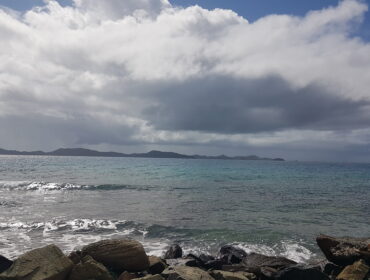…High surf advisory in effect for the British Virgin Islands…
Locations to be affected: Reefs and exposed northern and north-facing coastlines with relatively shallow, gently
to moderately sloping, nearshore areas.
Timing: Until next week Saturday.
Synopsis: Moderate long-period swells are reaching the area and are causing hazardous conditions along mainly
northern and north-facing coastlines. The threat level to the life, livelihood, property and infrastructure of those
using the affected coastlines is moderate with the potential for significant impacts. These swells could cause life-
threatening surfs and rip currents on affected coastlines. A high surf advisory means that dangerous surfs of 2 to
3 metres or 6 to 10 feet will affect some coastlines in the advisory area, producing hazardous conditions.
Seas (significant wave heights): 1.5 to 2.1 metres (5 to 7 feet), occasionally or locally reaching 2.7 metres (9 feet).
Swell period: 10 to 14 seconds. Swells: Northerly at 1.5 to 2.1 metres (5 to 7 feet) and occasionally higher.
Surfs (breaking swells): Over 2 metres (over 6 feet). These conditions are conducive for dangerous rip currents.
Please note that surfs could be as much as twice the height of swells, depending on the bathymetry of the
nearshore areas.
Coastal flooding: High tides combined with onshore wind and swell actions could result in localized coastal
flooding and beach erosion.
Potential Impacts: Loss of life–strong currents that can carry even the strongest swimmers out to sea; injuries to
beachgoers; beach erosion; sea water splashing onto low-lying coastal roads; beach closures; localized disruptions
to marine recreation and businesses; financial losses; damage to coral reefs; saltwater intrusion and disruptions
to potable water from desalination. High surfs can knock spectators off exposed rocks and jetties.
Precautionary: Beachgoers, especially to the mainly affected coastlines, should be extremely cautious; bathe only
where lifeguards are present or on the sheltered, less affected beaches, mainly to the south. Extreme caution is
also required by those using the affected non-beach or rocky coastlines.
Rip currents are powerful channels of water flowing quickly away from shore, which occur most often at low spots
or breaks in the sandbar and near structures such as groins, jetties and piers. If caught in a rip current, relax and
float. Don`t swim against the current. If able, swim in a direction following the shoreline. If unable to escape, face
the shore and call or wave for help.





